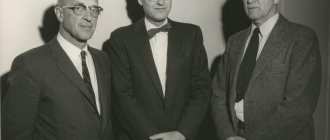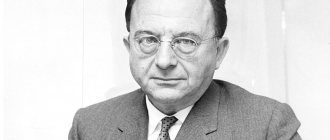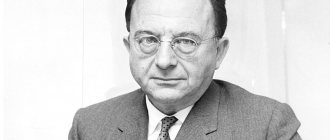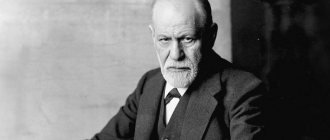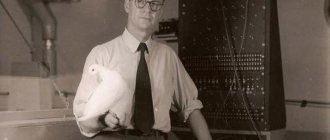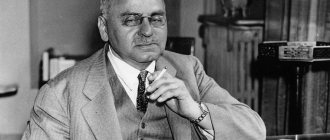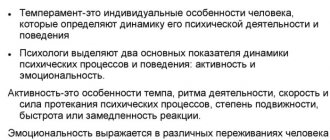Psychosynthesis is one of the branches of transpersonal psychology, which represents the integration of several approaches and has found application not only in psychotherapy, but also in training systems that use an integral approach, which is also used as an effective method of independent study and development of one’s own personality. The basis of this concept is Assagioli's theory of psychosynthesis, which is not a new result of research or invention, but is a combination of several different schools of psychology. By taking the most consonant with one’s own ideas and effective methods of psychoanalysis, Jungianism and other directions, and combining them, a new system was obtained that allows a person to independently analyze his personality, its needs and make adjustments and restructuring.
Goals of psychotherapy in psychosynthesis
The previous article, devoted to Assagioli’s theory of personality, ended with a discussion of the goals of psychotherapy, which naturally flowed from the author’s ideas about the structure of the human psyche.
The main goal (the maximum program) could be formulated as the individual’s realization of his higher “I” and the subsequent radical transformation of the personality structure in relation to this center.
According to Assagioli, only this option could comprehensively guarantee the mental health of the individual, namely, its internal consistency (integrity), which meant a person’s ability to live in harmony with himself and the world around him. In other words, such a transformation gave the individual a high quality of life, as well as the opportunity to ensure movement towards the same goal for other people. This is what it meant to live in harmony with the world.
A logical question arises here: if even traditional forms of psychotherapy that do not set such ambitious goals cause a lot of difficulties for the client, can we count on the fact that the method involving a radical restructuring of the personality will work? Even if one could admit that psychosynthesis is a good enough method for those few who are ready to go to great lengths in order to achieve, albeit a bright, but such a distant and vague goal, will it be suitable for any noticeably larger audience? Is it possible to talk about some kind of universality in the context of such a method, or was it doomed to become a method only “for the elite”?
This is what Assagioli himself said about psychosynthesis: “This is a great and, of course, long and difficult undertaking, and not everyone is ready for it.”
It is clear that any psychological work is difficult by definition. The reason is that virtually any method, if it involves actual work and not its imitation, is associated with the need for changes in personality. And these changes are proportional to the scale of the psychological problem being solved.
Therefore, understanding all the incredible difficulties of realizing the result set by psychosynthesis, even in the case of a very purposeful and talented person, Assagioli always said that this work is as complex as it is gradual. And psychosynthesis was conceived by him as a matter (neither more nor less) of a person’s entire life, and that is why it was divided into stages that were fundamentally different in level and in their tasks, which, nevertheless, merged into a single and harmonious system.
Psychosynthesis is a complex and gradual process.
Books
Assagioli wrote few books: “Psychosynthesis”, “Act of the Will”, “Typology of Psychosynthesis”, “Transpersonal Development”, “On the Spiritual Crisis”; but more than a hundred articles have been published in scientific journals. He did not like to spend time on academic work, but preferred consulting patients and teaching.
He was not only a famous scientist, but also an inquisitive person. Until his death, he did not stop in self-education and research. Assagioli was modest and did not achieve worldwide fame. But his teachings still live today and are actively used in psychology and psychotherapy, increasingly supplemented by new research.
Stages of psychosynthesis
“Between the starting point of the path, which begins in the valleys of our ordinary consciousness, and the sparkling peak of Self-realization, there are intermediate phases, plateaus of varying heights, where a person can rest and even settle if he cannot or does not want to continue the ascent” (Assagioli R. Psychosynthesis).
In total, Assagioli's system of psychotherapy has four main stages, which, however, often intersect and change their sequence in the process of work. These are the four stages.
1. Stage of knowing yourself. 2. Control over elements of your personality. 3. Work to comprehend your real (higher) self. Finding a unifying center to create a new personality structure or its creation. 4. The actual process of psychosynthesis, which means the creation of a new personality based on the unifying center of the true Self.
This is how we consider this method from the point of view of its application in the context of a gradual impact on the individual.
For a better understanding, it should be mentioned that Assagioli himself initially identified only two main stages in his method.
— The first is the formation of a full-fledged personality, or in other words, the personal stage of psychosynthesis. — The second stage was the level of spiritual transformation or spiritual psychosynthesis, the end of which marked the formation of a completely new personal structure.
Through these two stages, we can look at the method from a slightly different perspective, from the point of view of achieving an intermediate and final goal. And here the logic of psychosynthesis seems completely clear to us - first we “deal” with the personality and its problems and only then proceed to what is the true goal - the awareness of the true “I” and the subsequent spiritual transformation of the individual.
*Currently, followers of the Assagioli method prefer to talk about three stages - personal, transpersonal and spiritual.
Personality diagram according to Assagioli
Let's look at each stage in more detail
1. Know yourself.
According to Assagioli's idea, the very first stage involves a combination of psychoanalysis with elements of analytical psychology. This means deep work on exploring your unconscious, both its lower and higher layers.
By exploring the area of the lower unconscious, we identify our past suppressed traumatic experiences, analyze their impact on our behavior and state of mind, and through awareness of these connections we learn to understand the nature of our neurotic states.
In addition to the very fact of such understanding, the process of exploring and becoming familiar with the neurotic contents of the unconscious and its awareness through the emotional experience of past events is deeply beneficial and carries a considerable therapeutic effect. In fact, the method of psychoanalysis is built on this, but Assagioli found its drawback and limitation in the fact that from the point of view of this method, psychotherapy ended there, and this was completely insufficient in the context of the tasks of psychosynthesis.
Assagioli believed that at the first stage of self-exploration it is necessary, among other things, to explore the areas of both the middle and higher unconscious, because they concealed the greatest potential in knowing one’s capabilities, set new guidelines, and also stimulated the emergence of higher-level needs in the client , or, as Maslow said, META NEEDS.
In addition, metaneeds played a huge role in shaping the individual’s energy to move forward and served as a guarantee that the person would not stop halfway. Thus, the higher unconscious had to become the source of the will to change or inner intention.
2. Control over personality elements.
Of course, simple knowledge of oneself and awareness of the causes of neurotic processes would be completely insufficient. It was necessary to learn to manage what was realized.
It was with control over one’s own personality, in Assagioli’s understanding, that what could be called a full-fledged individual began, and only starting from this stage, it was possible to say that a person could potentially be ready for further movement towards understanding his transpersonal (non-personal) aspects.
The task of the second stage (control) was to integrate the various parts of the personality realized at the previous stage around the conscious self (personal self).
The goal of this stage was to form a personality that fully or at least partially solved the problem of internal contradictions that underlay neurotic behavior and could become a serious obstacle at the stage of transpersonal work.
In such a personality, all its components were, if not in harmony, then at least relatively consistent with each other, which means that the individual had the opportunity to independently cope with his neurotic tendencies, as well as interact much more effectively with the outside world.
For the second stage it was supposed to use two main methods - disidentification and work with subpersonalities.
The main motto and at the same time justification for this method could be considered the following words of Assagioli:
We are dominated by everything with which we identify ourselves. We can dominate and control everything with which we have disidentified ourselves.
Disidentification
Just as with subpersonalities, identification works with everything that controls a person’s consciousness. This is the basic principle of psychosynthesis - to free a person from everything that prevents him from revealing his higher self. Any process, complex, thoughts, feelings can capture consciousness and control behavior. A person can always separate himself from the process. It is this inner core that you need to rely on and make a choice.
A person can choose the path of development, choose how to react and live. And he can become the person he wants. The main thing is not to deviate from the right path. A person loses himself if he identifies himself only with the body, or only with the intellect. Or chooses only social roles. Personality is always broader.
By synthesizing yourself, dividing yourself into different parts, you can study all your strengths and weaknesses. Those subpersonalities that provide power, energy, resource, you can lead, give them more space. But you are always the main one - your higher self.
Psychosynthesis is a painstaking study of oneself. By removing roles, masks and attitudes, like husks, layer by layer, you will reach the depths of your consciousness. On this path, you will reveal all your best qualities and strategies, cope with your disadvantages and cover your weaknesses. By getting to know oneself, with the help of psychosynthesis, a person gains integrity and harmony.
Subpersonalities in psychosynthesis
We often identify ourselves with one or another important side of our nature, for example, an airplane pilot considers himself a pilot and when communicating with people and in conversation with himself often behaves accordingly; a woman who devotes herself to giving birth and raising children sooner or later begins to identify with the mother, a beautiful woman who works in television can easily identify with what is most important for this work, namely, a perfect and beautiful body, a scientist identifies with his intellect and so on.
However, this is just one side of our personality, which, for certain reasons, has become more important to us than others, that is, it has acquired value for us. We may have several such parts of the personality with which we identify, for example, a pilot may simultaneously associate himself with the father of the family, with a friend, with a traveler and with any other role that he plays in life and which is one of the key (important) ones. .
The human self can identify with any part of consciousness, but the reverse process is also possible, when we separate ourselves from what is unpleasant to us or from what, against the background of our main part, does not seem so important to us.
Assagioli called such semi-autonomous mental formations in a person’s personality subpersonalities .
The phenomenon lies in the fact that these entities, being just a part of our personality, often manifest themselves as completely autonomous creatures.
Thus, the subpersonality of the mother, with complete identification with her, can lead to the fact that a woman begins to behave as if, in general, she was only a mother, considering all her life interests, goals, meanings only in this context. At the same time, the other aspects of her personality were, as it were, in the shadows, that is, they were not so important.
Definition of subpersonality: this is a set of behavioral reactions, attitudes, motives, emotional states, thoughts that acquire integrity and relative autonomy in our consciousness.
Subpersonalities are metaphors in psychology. Man, as a being living in the material world, often deals specifically with material entities, and he tends to endow the formations of mental reality with the same characteristics. Therefore, you should always remember that such a metaphor is actually a very big convention. At the same time, one should not think that since these conventions do not have clear boundaries, they are illusions. The phenomenon of consciousness lies in the fact that these boundaries exist and they are set by the individual himself, which, in itself, is very good news, since it means the possibility of control over consciousness.
Work with subpersonalities is built on this idea. We can isolate any parts of our consciousness we need and communicate with them as with real living beings, conduct a dialogue with them, travel, create, negotiate, and also subject them to transformations.
The most common subpersonalities are our social roles, which we ourselves form on the basis of our significant drives and ideas about their implementation. Examples of such subpersonalities are father, daughter, husband, teacher, scientist, mother, businessman, politician, etc.
Each person contains quite a lot of such mental formations and they are not necessarily as global as subpersonalities associated with social functions. Examples of other subpersonalities are fear, prudence, smart guy, poor thing, scoundrel, adventurer, lone wolf, tramp, etc.
Subpersonalities play an important function in our lives; they allow us to quickly rearrange our behavior, and therefore effectively respond to various life situations.
Each subpersonality carries a certain useful function, for example, fear, this is an absolutely necessary survival tool for us; we need laziness in order to restore our strength at favorable moments and accumulate it for future use; we need anger so that when we meet an enemy we can win the fight. Social subpersonalities allow us to effectively do our job, for example, the subpersonality of a doctor allows a person to be an effective professional, the subpersonality of a mother allows a woman to take good care of her child, etc.
What's the problem? Unfortunately, almost always there is a process of identification with one or another subpersonality and then, to a large extent, it loses its practical meaning. And this means that we stop using them only as a practical tool, we get involved in them, we begin to think that we are this subpersonality. It is at this moment that we lose control over them, and they, on the contrary, gain power over us.
And the problem that arises here is that a person tends to identify with these tools, becoming extremely dependent on them.
For example, the subpersonality of a mother usually has great value for a woman. But children grow up and leave home, familiar relationships change, which often becomes a reason for suffering. The reason for suffering is that such a valuable subpersonality for a long time loses its significance - the mother’s life loses its meaning. An even greater problem arises for people who associate themselves with their young and healthy body, when natural maturation and fading completely deprives a person of the object of his affection.
Another significant problem is that we often have several different subpersonalities whose interests are directly opposite, for example, the subpersonality of a worker and the subpersonality of a lazy person, the subpersonality of a family man and the subpersonality of a tramp, etc. Naturally, such combinations cannot but give rise to internal conflicts.
It was said above that subpersonality is what we identify ourselves with, with which our personality currently correlates itself. One point is very important here - we do it ourselves, we endow ourselves (subpersonality) with certain properties, which we ourselves choose (define as significant). This means that any of the components of the definition of subpersonality (see above) contains a sufficient condition for the formation of subpersonality. In other words, subpersonality is not necessarily a full-fledged social role, because we can identify ourselves with a more elementary mental formation, for example, with emotion.
And this means an important practical thing - in psychosynthesis we can arbitrarily choose exactly that part of our mental reality with which we want to work.
Working with subpersonalities. Disidentification.
It was previously mentioned that the main method of the second stage is work with subpersonalities, which includes two stages:
- detection and awareness of subpersonalities,
- disidentification with them.
Subpersonalities may or may not be conscious of us. Therefore, in order to work with a subpersonality, you must first discover it and recognize its existence as a real part of yourself.
Here you can do without meditative work, using rational methods. For example, for starters, you can try to answer the question “who am I?” or “who do I associate myself with” 10-20 times? Most likely, among these answers there will definitely be several of the most important subpersonalities.
Of course, not all of them are available for immediate and quick awareness. So, in order to discover significant subpersonalities located in the areas of the lower and higher unconscious, rather long and difficult work is required. Discovering significant subpersonalities is only part of the story; most importantly, it is a process of disidentification.
In fact, this work consists of knowing the subpersonality - recognizing it as a part of our psyche, which is a necessary and useful part of our consciousness. For this purpose, exercises are used when the client imagines the subpersonality with which he will work, evokes its image in consciousness, after which quite a lot of options are possible, ranging from simple contemplation of the subpersonality and ending with an imaginary dialogue with it, a walk or observation of its transformation. This work may seem simple and time-consuming only at first glance. In fact, we are talking about developing in the client the basic skills of concentration and calming the consciousness, which is highly desirable for deep work with subpersonalities.
An important part of this work is to clarify the method of psychosynthesis and its stages to the client; the person must believe that it really works, only in this case can real results be expected from therapy.
As a result of successful work, subpersonalities, which previously were semi-autonomous parts of our consciousness, are realized by the client.
- as if they really existed.
- as useful and necessary parts of the psyche, which, however, are only practical tools, effective roles that we can simply use without completely identifying with them.
-and third, which is the most important thing, as a result of this work there should be an awareness of one’s personal center, and ultimately a feeling of the true unity of this center with all subpersonalities, and otherwise - the awareness that we are a multifaceted, but unified whole, possessing the capabilities of transformation, which give us subpersonalities.
If such a unification is truly successful, then any subpersonality actually becomes a servant of our common unifying center (that is, it performs the function initially assigned to it), and the lost identification (identification) with subpersonalities releases a lot of energy, which is absolutely necessary for a person for the next very difficult stage.
3. Work to comprehend your real (higher) self. Finding a unifying center to create a new personality structure or its creation.
Personality structure and temporary unifying center.
This stage marks the beginning of a new stage of work - the transition to transpersonal work, that is, affecting BEYOND the personal aspects of consciousness. The main task that is set at this stage, and the implementation of which means its completion, is the comprehension of one’s higher “I”, that asterisk on the diagram that crowns the personality model.
Assagioli believed that if the previous stages were successfully completed and in the presence of favorable circumstances, this process could happen to a person in a completely natural way, during his normal life circumstances. The reason for this is the activation in the course of work on oneself of METAPHANDS - the desire for the realization of the higher self.
Let us remember that Assogioli spoke about this desire as immanently inherent in any personality, which means that if all obstacles are removed, the process could well go on by itself.
Of course, much more often, personality transformation was not so simple and quick, and a lot of additional work and the use of more active methods were required to activate it.
The main method that was practiced at this stage was the creation of an ideal image (ideal self), corresponding to the client’s ideas about his ideal and at the same time the principle of reality, that is, the real capabilities of the individual and the subsequent implementation of this ideal image. Such an image could be created naturally, only on the basis of a person’s real life needs, for example, if a person was an artist, then it could be the image of an ideal artist creating great art, if a woman was a mother, then she created an ideal image of a mother for herself, and so on.
Of course, this method was associated with a new identification, but it made it possible to set a certain vector of movement towards the goal, create a powerful intention and, with the proper attitude and perseverance, allowed one to successfully move towards an intermediate result. The calculation here was made that in the process of moving towards a high result, a spontaneous transformation of personality would occur, liberation from egoistic aspirations, and as a result, a special state of consciousness would be achieved when the true source of the Self would be recognized and recognized as the unifying principle of the entire personality structure.
The figure shows the already familiar personality diagram in psychosynthesis, supplemented by an artificially created unifying center. this diagram exhaustively illustrates the third stage of psychosynthesis.
You should pay attention to an important point - to move to the third stage, you need to go through the previous two, which in itself is very difficult, because passing them implies awareness and acceptance of all your subpersonalities, including (primarily) those that people usually do not recognize in no case do they want to. Without fulfilling this condition (awareness and acceptance of all parts of oneself), the creation of an ideal self will turn into another illusion, a dead-end path, which those who practice so-called “positive psychology” so often sin with.
4. Creation of a new personality based on the unifying center of the true Self.
The task that is set before the individual at this final stage is, in fact, what the word “psychosynthesis” means, namely, the creation around the found and realized true Self of a completely new personality, harmonious and holistic.
Assagioli said that after comprehending his true self, there is a high probability that a person himself will clearly see the main guideline of his life, which means that his new personality will spontaneously build around this center. Such people see clearly from the very beginning what they are and what they need to be, and how to act in the context of newly discovered circumstances. This happens if the third stage is basically completed, the true Self is fully realized, obstacles are eliminated, and the personality is in a state of complete harmony.
The intuition that pushes a person to change must be true and, if there are illusions about oneself, this only means that the previous stage was not completed and one should return to the previous levels and continue working there, that is, turn to the previously created model of the ideal self and, perhaps, make some adjustments to it.
This model of the ideal Self, if it was created correctly, without illusions and excessively high standards, already contains sufficient conditions for achieving the goal.
However, the whole point is that the transition from the third to the fourth stage does not necessarily have to occur in some ideal way; most often it happens that the boundaries between all stages are quite blurred, transform into each other, and the individual following the path of psychosynthesis is constantly moving then forward, then back, returning to the previous level, even after achieving certain successes at a higher one.
Therefore, in the case of a person who has achieved and realized his true Self, but for some reason is experiencing difficulties, Assagioli recommended approaching the matter using special stage methods, which included psychosynthesis itself.
There were several possible stages at the final stage.
1. As at the previous level, you should set (define) your ideas about who a person would like to become. At this stage, the level of identification with the ideal spiritual Self is much less, and the qualities of the new personality are much more conditional. We are talking here only about certain landmarks that set the general vector of movement.
2. Comprehensive use in real life (and not in the imagination) of the capabilities achieved at the previous stages - intuition, freed energy resources, acquired knowledge about oneself and the world.
3. If necessary, do not have doubts and return to any of the previous stages, to the development of missing personality qualities, to training the necessary mental functions, constant work to improve the state of integrity, achieving intrapersonal harmony through coordination and subordination of opposing mental tendencies.
4. Continue working with subpersonalities that for some reason interfere with movement towards the goal, use the energy of hidden aspirations of various areas of the unconscious. The lower - through awareness, acceptance and subsequent transformation into useful energies. The Highest - through awareness and subsequent conscious use of these aspirations.
5. Constantly develop new capabilities in yourself and do not stop there.
6. Be vigilant in relation to yourself, in order not to become a victim of the desired ideas about successful spiritual development, while true progress is far from being so impressive, in other words, be honest with yourself.
This is what Assagioli’s recommendations look like for those who work at the 4th stage of psychosynthesis.
In conclusion, it would not be out of place to say that the author himself has repeatedly warned against an overly technical understanding of his methodology. Psychosynthesis is not a method of psychological work in the usual sense of the word.
He himself said the following about his method:
“Psychosynthesis is, first of all, a dynamic, even dramatic concept of our mental life, which appears as a continuous interaction and struggle of many different, including opposing forces with a unifying center that is constantly trying to manage them, coordinate them with each other and use them.”
Thus, the path that Assagioli declared is nothing more than a certain general vector of human development, which involves a fairly creative use of the developed methods, extensive use of intuition, both of the client and the supervising psychologist, a constant return to the initial stages of work and, of course, constant personal work of the client in life, and not just in the psychotherapist’s office. The latter is especially important because it greatly increases the likelihood of a good result and forms the so-called intention for life, a general incentive for development, without which everyone will be doomed to endless repetitions of the same cycles regarding the constant beginning and end of practice, new return, repetition and so on.
Assagioli spoke more than once about his method as merely an attempt to help a person create internal harmony between two opposing aspirations for plurality and unity and, in this harmony, finally achieve internal unity. This task was seen by him as a natural fulfillment of what he called the Spirit, the Divine Being or Cosmic Energy. What everything that exists strives for.
It would be best to say in the words of the Master himself about this desire:
“bringing order, harmony and beauty, and also uniting all beings in the bonds of love, brings about - slowly and quietly, but surely and inevitably - nothing less than the Supreme Synthesis.”
Comment via Facebook
Comment
Rationalization
Miscalculations, mistakes and other people's opinions hurt when they resonate with negative identities from the unconscious, as if they force you to admit what a nonentity you are.
In this vein, even neutral observations about someone else can suddenly cause resentment and anger simply because they touch old wounds. Positive assessments are pleasing for a similar reason - when they give subpersonalities confident in their right to recognition and love a chance to wake up and come into force.
Resonance with the situation connects a specific role, which seems to be inherent in the behavior occurring. Failure brings out the inner loser, success is the darling of fate. At the same time, the next subpersonality initially functions in complete isolation from the actions that it ascribes to itself, and arises as a subsequent mental reaction to these actions - a rationalization of what has already happened. That is, first the behavior is implemented and only after that an image of oneself arises in the consciousness, which takes this behavior personally.
Imagine a writer who has created two independent stories - in one he depicts a self-satisfied “sinner” who considers himself to be a righteous man, in the next - a repentant righteous man who suddenly realizes that he is the sinner from the first story. Both personalities are fake and miss the main thing - their own source - the space of the creative mind in which they arose.
This is how the appearance of a false unity of contradictory subpersonalities is maintained. What unites them is only the “canvas” on which they replace each other.
How to recognize dissociative disorder
Patients with DR share the following characteristics:
- amnesia for the events of school years;
- memory lapses, disorientation in time;
- confusion with dates;
- statement about oneself in the third person;
- feeling of extraneous noise in the head, presence of voices;
- the inability to explain the appearance of certain things in the house;
- people greet the patient, call him by name, but he does not know them;
- relatives tell episodes with their participation, which patients do not remember;
- sudden, uncontrollable appearance of incomprehensible thoughts that do not belong to the patient.
In addition to the main signs, there are general symptoms such as:
- headaches, sleep disorders;
- mood instability;
- eating disorders;
- panic attacks;
- anxiety and phobias;
- depression, suicide attempts;
- sexual dysfunction;
- self-harm.
There are many examples of patients with DID, each of which is unique. Here is the story of a girl in whom 12 other selves coexisted at once. One of them was a little girl of three years old who loved strawberry gum and a cartoon about a little pony. She could wake up her parents in the middle of the night to ask for a walk or show her drawing. I spent days watching TV and painting the walls.
In contrast to the little girl, there was a malicious woman who forced the girl to hurt herself. This happened as a punishment for the wrong actions of the main personality. On the other hand, this subpersonality came to the defense if there was a threat. Once a young man tried to raise his hand against a girl, then a malicious woman intervened, pressing the guy to the wall.
Another alter state is also a young girl. She is charismatic, sociable, and loves to be the center of attention. Such traits contradict the character of the hostess. At first, the girls didn’t get along, and the shocking subpersonality tried to do something contrary to the main one: dye their hair inappropriately, dress inappropriately. Then the “main” girl decided to make friends with her. And since then they have coexisted in harmony. The rebel, replacing her, could go to school and do the usual household chores. In general, she behaved with dignity.
There are also some incidental cases. The accused and the victim, both with DID, met in court. The accused is a mature man, he is charged with illegally entering the home of the injured woman and committing an act of sexual violence against her. The man denies his guilt, claiming that the actions were committed by one of his 30 subpersonalities – Spirit with one of the other “I”s of the victim – Laura.
“Autogenic training – prevention of neuroses”
In recent years, autogenic training (AT) has been successfully used not only for the treatment of neuroses, but also for angina pectoris, psychophysiological rehabilitation of post-infarction patients, vegetative-vascular dystonia, the initial stage of hypertension, neurodermatitis and other diseases. AT helps reduce emotional stress, feelings of anxiety and discomfort, has a normalizing effect on the state of basic physiological functions and the regulation of metabolic processes in the body. At the same time, sleep is normalized, mood improves, and the entire person’s personality is activated.
It is best to do autogenic training while sitting or lying down in a quiet and calm environment. The first stage of AT includes five exercises.
- Causing a feeling of heaviness.
- Inducing a feeling of warmth.
- Regulation of cardiac rhythm.
- Regulation of breathing.
- Effect on abdominal organs.
- Effect on the vessels of the head.
All exercises are performed with eyes closed, self-hypnosis formulas are repeated only while exhaling. After performing the exercises, it is recommended to sit quietly for one minute and only then remove yourself from the state of autogenic immersion, saying the formula: “Bend your arms, take a deep breath, open your eyes as you exhale.” About 2 weeks are allotted for mastering each exercise, and 3–4 months for the entire course.
1.doc
3
^ PSYCHOSYNTHESIS R. ASSAGIOLI
analytical, synthetic.
Self
^ Lower unconscious
ItIt
^ Middle unconscious (preconscious) ^ Higher unconscious (super-unconscious)
SelfSuper-Self
^ Field of consciousness ^ Conscious Self (or the Ego proper)
Self
Higher Self Self
^
Collective unconscious Self
Self psychosynthesis of the unifying center Self
^ Deep comprehension of the personality
of the lower unconscious Onofantasy, mental image ov , dark forces of the lower unconscious true calling
^ Identification of the basic elements of personality and control over them Disidentification
of disidentification with
^ Work with subpersonalities
disidentification of disidentification true (higher Self as a unifying center Self as a
as an external unifying center,
Self and
with magotherapy
image of reincarnation into the inner world of the hero through imitation of his external image and behavior patterns Self
^ Choosing the ideal model of your desire wow I (Not
I
introverts extroverts ambaverts,
I
^ Constructive use of all energy resources
I
transmute the ideal model ^ Complementation or development of missing or “underdeveloped” elements of the personality
of the ideal EI
Internal
self-hypnosis
External
effective formation and improvement ^
Harmonization of personality structure PRACTICUM Workbook rational
V.P. Simonovarational psychotherapy of systematic desensitization
^ Your capabilities Who am I? Disidentification
“I have a body, but I am not a body. I treat my body well, I take care of its cleanliness and health, but I am not only a body.” “I have a body, but I am not a body.” “I have there are feelings, but I am not feelings. I have different strong feelings, they change from joyful to unpleasant, from love to enmity, but my true Self does not change with them. Feelings come and go, but my Self remains.” I have feelings, but I am not feelings." "I have intellect, but I am not intellect." "I have a body, but I am not a body. I have feelings, but I am not feelings. I have intelligence, but I am not the intellect.” “I am the master, and not the slave of my body. I am the master, and not the slave of my feelings. I am the master, and not the slave of my intellect.”
Subpersonalities
At this point we advise the client to ask his other subpersonalities to speak critically about this subpersonality.
^ Climbing.
In the garden workbook
I am not a role
“What I don’t like about myself now is not my unchanging essence. This is just one of the roles that I can play differently or refuse to play at all. I am the master of my roles, not a slave to them "
^ Identification with the center of the Self ^ Formation of an ideal personality
of a pure Self Ideal Self Ideal Self Imagotherapy Self
Synthesis
3
Site search:
Bibliotherapy
An important indicator for assessing the effectiveness of bibliotherapy is the patient’s interest in reading. If it decreases, one can judge the deterioration of health.
There are different typologies of effects and functions of the therapeutic method:
- Information functions. Reading provides information and increases knowledge while reducing fear of the unknown. This function is inherent in scientific literature.
- Educational function. Reading brings perspectives and opinions that enhance education.
- "Mirror" function. The reader compares the author's views with his own views, changing his own opinion based on this comparison.
- Identification functions. The reader finds an example or identifies with a character.
- Cleansing function. When reading a book, psychological cleansing (catharsis) can occur. To achieve this effect, the work must be able to perform this purification and the reader must be willing to experience catharsis while reading.
- Aesthetic function. The book affects the reader aesthetically.
- Relaxation function. Providing relaxation and relaxation.
Story
According to the historian of dynamic psychiatry (d) Henry Ellenberger (d), the source of the doctrine of subpersonalities are the theories of dippsychism and polypsychism, popular among mesmerists of the 19th century. The greatest contribution to the construction of dippsychism was made by Max Dessoir (1867–1947), while the historian considers magnetizer Joseph Pierre Durand (1826–1900) to be the author of the term “polypsychism.” Durant argued that the human body consists of anatomical segments, each of which has its own psychic ego. In Ellenberger's view, Sigmund Freud's and Carl Gustav Jung's ideas about the unconscious were first based on the model of dippsychism, but subsequently evolved towards polypsychism. The historian considers the three-member formula to be an example of polypsychism in Freud's teachings: Ego, Id and Super-Ego.
The concept of subpersonality was introduced into scientific use within the framework of psychosynthesis (psychotherapeutic system), developed by the Italian psychiatrist and psychologist R. Assagioli. In accordance with his ideas, subpersonality is a dynamic substructure of personality that has a relatively independent existence. The most typical subpersonalities of a person are those associated with the social (family or professional) roles that he takes on in life, for example, the roles of daughter, mother, son, father, grandmother, beloved, doctor, teacher, etc.
Personality scheme
All this research and development provides such a mass of material that it is quite possible to try to internally coordinate and synthesize it. If we collect firmly established facts, reliable and well-verified information, as well as sufficiently reasoned explanations, without paying attention to the excesses and theoretical superstructures of various schools, we will obtain a multidimensional concept of human personality; being far from perfection and completeness, this concept seems to us more meaningful and closer to reality than the previous ones.
To illustrate this concept, we will use the diagram below. Of course, this is a schematic and extremely simplified image that can only give a structural, static, almost “anatomical” idea of the structure of our inner world, while its dynamic aspect is more important and significant. However, here, as in any science, the steps must be consistent, and the refinements must be gradual.
When dealing with such a plastic and elusive reality as our mental life, it is important not to lose sight of its main directions and the fundamental differences that exist between them; otherwise, numerous details can obscure the whole picture from us and prevent us from realizing the meaning, purpose and value of its various parts
Subject to these reservations and limitations, the map of our inner world looks like this:
Psychology around everyone
Psychology is not just an academic discipline that exists only in classrooms, laboratories and psychology waiting rooms. We encounter the principles of psychology every day in the most ordinary situations. Print advertisements and advertisements that appear on television every day are based on psychological influence to convince us to buy the advertised products and services. Various web resources that we regularly visit online also use this science to understand how people read and interpret information from Internet pages.
Types of DID
There are two forms of the disease: non-possessed and possessed.
The non-possessed form is manifested by minor external changes in the patient, sometimes unnoticeable to others. The patients themselves characterize their own condition with the following sensations:
- they contemplate their own lives as outside observers, unable to intervene in the course of events;
- feel detached from their own physical and mental state;
- feel bodily changes - consider themselves old, too young, a person of the opposite sex;
- talk about the unreality of what is happening;
- They notice the influx of an endless stream of thoughts, they notice previously alien emotions.
Hints of the presence of a disorder can appear in individual details. For example, a person suddenly changed his image and is interested in things that were previously insignificant to him. Eating habits and emotional characteristics change. For example, a previously balanced individual is now characterized by short temper, nervousness, and anger.
The possessed form is characterized by a sharp change in behavior, noticeable to all people who know him. The patient is called by someone else's name, actions become different from the usual. The patient represents a new person or being. Often patients are presented as God, a demon, an angel. The split ego explains the previously existing concept of “possessed by the devil.” Shamans are considered the first representatives of dissociative disorder. Drawings from the Paleolithic period were found confirming the reincarnation of sorcerers into animals and the infusion of spirits.
Perhaps the most famous multifaceted personality is Billy Milligan. 24 autonomous ego states coexisted in it simultaneously, 10 of which were basic. Billy was considered the main one. Arthur and Ragen Vadaskovinich are also interesting.
Arthur is a 22-year-old Englishman, highly intelligent, educated, and mannered. In the scientific and medical field - a high specialist. Rejects the existence of God, wears glasses, smokes. It was he, guided by the deductive method, who discovered the presence of other subpersonalities and developed general rules of behavior.
Ragen Vadaskovinich is a native of Yugoslavia, 23 years old. Called the "guardian of hatred." Extremely strong, distinguishes all types of weapons. He treats women and children with special respect and always helps them. A large, strong guy, along with Arthur, controls the overall body, regulating dangerous situations.
In addition to the previous guys, among the 10 main identities are an 18-year-old eloquent scammer, a 14-year-old boy, Danny, who is afraid of men, and 3-year-old Christine, who appeared first among the rest of the Ego States. The girl stood behind Billy in the corner when he did something wrong, Ragen's favorite.
There was also Christine’s brother Christopher, lesbian Adalana, little David who accepts pain, Tommy’s keeper of salvation, helping to get out of limiting circumstances. For example, he knows how to remove handcuffs.
The remaining 13 subpersonalities were declared undesirable by Arthur and Ragen for inappropriate, antisocial behavior. For example, Phil and Kevin organizing armed attacks. It was for them that the “real” Billy was tried, as well as for the rapes committed by the lesbian Adalana due to a lack of love, warmth and the need for hugs.
Billy Milligan is famous for being accused of robbery and rape, but acquitted. The man became the first defendant acquitted of the diagnosis of “Multiple Personality.” Lawyers were able to prove that several of Billy's alternate identities were guilty of crimes. He was sent to a psychiatric hospital to receive treatment until he fully recovered. After 10 years, Billy was cured and released from the hospital.
The cause of Billy Milligan's disorder is believed to be a difficult childhood. The boy's father suffered from alcoholism, depression, and committed suicide when the boy was 6 years old. Eight-year-old Billy's stepfather tied up and raped the boy in a barn. The moment when a guy’s first new identity emerges is considered to be a period of 3-4 years.
Subsequently, the story of Billy Milligan was outlined in his novel by Daniel Keyes, calling his work “The Many Minds of Billy Milligan.”


